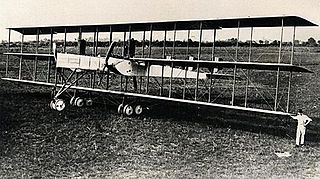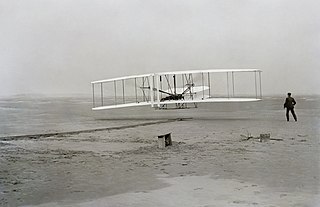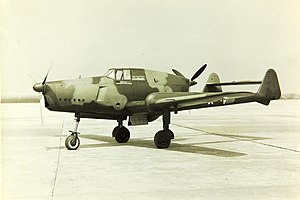
The Dornier Do 335Pfeil ("Arrow") is a heavy fighter built by Dornier for Germany during World War II. The two-seater trainer version was called Ameisenbär ("anteater"). The Pfeil's performance was predicted to be better than other twin-engine designs due to its unique push-pull configuration and the lower aerodynamic drag of the in-line alignment of the two engines. It was Nazi Germany's fastest piston-engined aircraft of World War II. The Luftwaffe was desperate to get the design into operational use, but delays in engine deliveries meant that only a handful were delivered before the war ended.

The Douglas XB-42 Mixmaster was an experimental bomber aircraft, designed for a high top speed. The unconventional approach was to mount the two engines within the fuselage driving a pair of contra-rotating propellers mounted at the tail in a pusher configuration, leaving the wing and fuselage clean and free of drag-inducing protrusions.

The Caproni Ca.4 was an Italian heavy bomber of the World War I era.

In aeronautical and naval engineering, pusher configuration is the term used to describe a drivetrain of air- or watercraft with its propulsion device(s) after its engine(s). This is in contrast to the more conventional tractor configuration, which places them in front.

An aircraft constructed with a push-pull configuration has a combination of forward-mounted tractor (pull) propellers, and backward-mounted (pusher) propellers.

The Avro Type D was an aircraft built in 1911 by the pioneer British aircraft designer A.V. Roe. Roe had previously built and flown several aircraft at Brooklands, most being tractor layout triplanes. The Type D was his first biplane.

The Fokker F.25 Promotor, first flown in 1946, was a single-engined, twin-boomed, four-seat passenger monoplane with a pusher engine mounted at the rear of a central nacelle. It was of wooden construction and has fitted with a retractable nosewheel undercarriage. One feature of the design was that instead of a 2 + 2 seating, the pilot sat in front to the left, and all three passengers were on a bench seat to the rear of him. Alternatively, when being used as an air ambulance aircraft, it could carry a patient on a stretcher, which was loaded through a hatch in the aircraft's nose. The F.25 was evocative of the pre-war G.I design.
The Pemberton-Billing P.B.25 was a First World War British single-seat scout aircraft built by Pemberton-Billing Limited, later Supermarine Aviation Works Limited.

The SAI-Ambrosini SS.4 was an Italian fighter prototype developed in the late 1930s, featuring a canard-style wing layout and a pusher propeller. Development of the SS.4 was abandoned after the prototype crashed on its second flight.

The Comte AC-3 was a 1920s Swiss bomber/transport aircraft produced by Flugzeugbau A. Comte.

The Farman F.50 was a French twin-engined night bomber designed and built by Farman as a replacement for the single-engined Voisin pusher biplanes in service with the French Air Force.
The Farman F.51 was a 1920s French maritime reconnaissance flying boat designed and built by Farman. The F.51 was an unequal-span four-bay biplane flying boat with a crew of four. It was powered by two Lorraine 8bd engines mounted in tractor configuration. A pusher engined version was designated the Farman F.50 . Tested by the French Navy but it failed to win any orders, Farman did briefly consider a civil version but the project was abandoned.

The PWS-20 was a Polish single-engine high-wing 8 passenger airliner, built in the PWS factory and when it made its first flight in 1929 it became the first Polish-designed transport aircraft to fly.

The Short Type 827 was a 1910s British two-seat reconnaissance floatplane. It was also known as the Short Admiralty Type 827.

The SECAN SUC-10 Courlis was a French high-wing touring monoplane designed and built by Société d'Etudes et de Construction Aéronavales (SECAN), a branch of the automobile company Société des Usines Chaussons. The aircraft had problems with the engine installation and only 144 were built, some without engines and were scrapped.

The Douglas Cloudster II was an American prototype five-seat light aircraft of the late 1940s. It was of unusual layout, with two buried piston engines driving a single pusher propeller. Only a single example was built, which flew only twice, as it proved too expensive to be commercially viable.
The Udet U 11 Kondor was a German four-engined airliner designed and built by Udet Flugzeugbau, only one was built.

The Curtiss Model 22 Cox Racers were two specialised racing aircraft built by the American Curtiss Aeroplane and Motor Company. The type was flown as a monoplane, biplane and triplane.
The Astra 1916 bomber was a large 3-engined biplane, with two fuselages and a central nacelle. Power was supplied by three 220 hp (160 kW) Renault 12Eb water-cooled V-12 piston engines, two tractor engines in the noses of the fuselages and a pusher engine at the rear of the central nacelle. The flight crew of two sat in individual cockpits in the central nacelle and a gunner were housed in a cockpit, aft of the wings, in each fuselage. Designed for a 1916 concours puissant the performance of the aircraft was unsatisfactory and further development was abandoned.
The Henri Farman HF.35 was a large 3-seat biplane designed and built in France by Henri Farman during 1915.

















